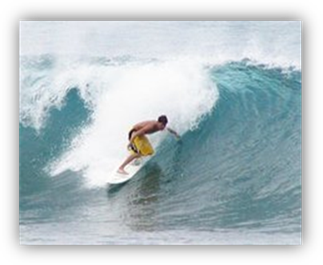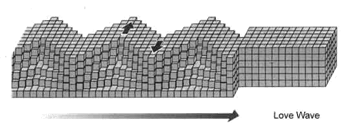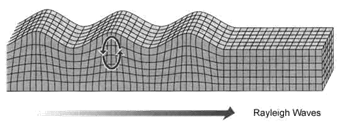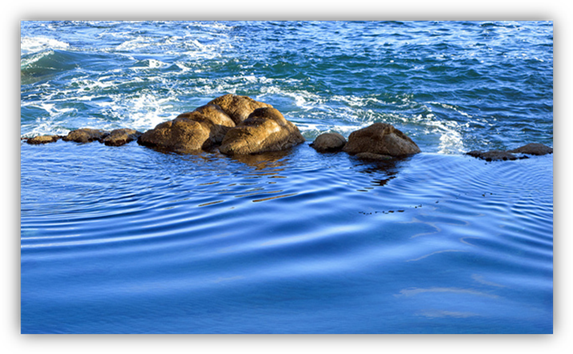
VIBRATIONS AND WAVES
Unit Overview
This unit will introduce factors
that affect wave motion, wave speed, and wave interference. The importance of waves and how vibrations
are related to them will also be discussed along with water, sound and seismic
waves.
Unit Review
In the previous unit, wave energy
was introduced. A wave was defined as a
traveling disturbance that moves energy from one location to another without
transferring matter. Properties of waves
and wave characteristics were discussed as well as the various types of waves,
how they form, and how they carry energy.
|
GLOSSARY OF KEY TERMS |
|
|
medium |
the substance or matter that a
wave moves through |
|
seismic |
vibration generated by an
earthquake, explosion, or similar phenomenon and propagated within the Earth
or along its surface |
|
out
of phase |
when one wave passes a given point
at the same time as the trough of the other wave, they become weaker |
|
in
phase |
when the crests of two waves pass
a given point at the same time |
|
rogue
waves |
these waves are sometimes referred to as “freaks of the
sea, they seem to appear out of nowhere, all of a sudden in the middle of the
ocean |
|
wave
interference |
the addition and subtraction of
wave crests and troughs causes wave interference |
|
earthquake |
the shaking and trembling that
results from the sudden movement of part of the Earth’s crust |
|
tsunamis |
giant sea waves |
|
secondary
waves |
seismic waves that do not travel
as fast as P waves |
|
surface
waves |
the slowest moving seismic waves |
|
primary
waves |
these waves travel the fastest and
arrive at a given point first, before any other type of wave |
|
seismologists |
scientists who specialize in the
study of earthquakes and seismic activities |
|
seismogram |
a recording of earth motion as a
function of time |
|
seismograph |
an instrument that is used to
detect and measure seismic waves |
|
Mercalli
scale |
measures the amount of earthquake
energy, not as a number, but as the amount of damage by the quake as reported
by observers |
|
Richter
scale |
a scale of numbers, it measures
the amount of energy released during a quake and the number will be the same
regardless of where it is measured |
For extra practice of your key
terms, click on the Key Terms
Crossword Puzzle PDF File.
Waves and Vibrations
Waves transfer energy, not matter,
along its path. Energy moves in waves
through matter or space. Changes occur
in matter when energy is transferred to it.
Because energy can do work, it can move matter. The energy carried by waves is transferred to
whatever stops a wave. Water and sound
waves are caused when something disturbs a medium. A medium
is the substance or matter that a wave moves through. Water is the medium of an ocean wave. Sound waves travel through solids, liquids,
and gases (air). Earth is the medium of seismic (earthquake) waves.
Water Waves
The source of a wave is the
disturbance that sets it in motion. Wind
is most often the source of water waves.
In the previous unit you completed an experiment with a spring toy
(slinky). That particular activity
introduced you to the properties of waves such as size and shape and how those
waves can vary. Terms such as crest,
trough, wavelength, frequency, and amplitude were introduced as properties of
wave energy. Complete the following
activity by observing the characteristics of waves in a wave tank:
|
Water Tank Waves |
|
You will need a tall and narrow glass
jar with a tight-fitting lid, cold tap water, blue food coloring, and
vegetable oil. ·
Fill the
jar 1/3 full of cold water. Add a
couple of drops of the blue food coloring. tighten the lid, and swirl the jar
just enough to mix the color evenly. ·
Next fill
the jar to the top with vegetable oil.
Screw the lid on tightly. Hold
the jar horizontally and move it gently back and forth to simulate the motion
of water waves. ·
Then use
more of a rocking motion and put more energy into the waves without changing their
wavelengths and frequencies. |
|
What happened in this
activity? Did you notice a change in
the amplitude of the waves as more energy was applied to them? Remember that the amplitude of a wave is
related to the amount of energy put into the wave. Amplitude is not determined by a wave’s
length or frequency. |
Factors That Affect Wave Motion
You have observed characteristics of
waves using water as the medium in which the waves transfer energy. Waves can also transfer energy through
solids, liquids, and gases, as well as through empty space (vacuum). Each of the waves you study in this unit will
have common characteristics that have already been identified with water
waves. The characteristics are
wavelength, frequency, and amplitude.
Wave Speed
To find the speed of a wave you
would multiply its frequency times its wavelength:
Wave speed = frequency x wavelength
Wave speed is the velocity of a
traveling wave. Remember that velocity
is speed in a given direction. Wave
speed is like frequency, except it applies to a wave that does not repeat. Here is an example of wave speed using an
everyday object: If you have ever tried
to straighten out a garden hose then you have observed wave speed. As you begin shaking the hose, you are
sending waves down it. The single
traveling wave travels toward the kink at a certain velocity – its wave
speed.
As was previously stated, a wave is
a disturbance that moves through a medium.
The medium could be water, air, or even a slinky. These media are distinguished by their
properties – the material they are made of and the physical properties of that
material such as the density, the temperature, the elasticity, etc. These physical properties describe the
material itself, not the wave. On the
other hand, waves are distinguished from each other by their properties –
amplitude, wavelength, frequency, etc.
These properties describe the wave, not the material through which the
wave moves. Only a change in the
properties of the medium will cause a change in the speed.
The following activity, Wave
Machine, is a demonstration of how energy can move through waves:
|
Wave Machine
Activity |
|
A. Obtain 1 m of 2 cm-wide un-stretched
elastic, 25 plastic drinking straws, staples and stapler, and a table. |
|
B. Take the length of elastic, 1 m, and lay
it across the table. |
|
C. Lay the 25 straws across the elastic
like railroad ties at right angles to the elastic. Make sure the same length
of each straw sticks out on either side.
Each straw should be about a finger’s width apart on the elastic. |
|
D. Use the stapler to carefully staple each
straw in place on the elastic. Staple
each lengthwise. |
|
E. Have a partner help you with this
activity. Pick the straw track up from
the table and hold it between you, so that the straws are positioned
vertically in the air. |
|
F. Move the straws back and forth gently at
one end. What is happening? Now do the same thing from the other end. What do you observe? |
|
G. Now tap them more quickly. Tape the two ends at the same time in
opposite directions, and then in the same direction. What happens as the waves collide? |
|
In this activity it was easy to
see the straws vibrate back and forth, but was the wave motion transmitting
energy? In Question #1 record your
observation. In Question #2 tell
whether energy or matter moved in the wave.
|
Wave Interference
How do powerful water waves
occur? When the crests of two waves pass
a given point at the same time, they are considered “in phase” and the wave crests add to make each other stronger. If the crest of one wave passes a given point
at the same time as the trough of the other wave, they become weaker. They are considered to be “out of phase” and interfere with each
other. This results in less water
height. If the crests of several waves
come together at the same time, they are “in phase”, which results in more wave
height. Water waves that are “in phase”
can suddenly produce a huge wave called a rogue
wave. Rogue waves have been known to
reach heights of 30 meters. Rogue waves
are sometimes referred to as “freaks of the sea.” They seem to appear out of nowhere all of a
sudden in the middle of the ocean as the crests of several waves overlap in
phase. Once the crests of the waves are
out of phase, a rogue wave can disappear just as suddenly as it appeared. This addition and subtraction of wave crests
and troughs is called wave interference. All waves have wave interference.
Wave interference can sometimes be
considered helpful. This was discussed
briefly at the end of the last unit.
Strong winds can make buildings sway several meters from their original
position. When this happens, the
oscillating motion makes the people inside feel nauseated and disoriented. During earthquakes, the same thing can
happen to buildings. Motions caused by the
wind can increase the energy of the earthquake waves if they have wave
interference that is “in phase.”
Buildings can collapse from the increased energy from the combined
motions.
Some buildings are designed to
withstand earthquakes. In the past earthquake-prone
buildings were designed with a safety approach that “more is better.” The designs included heavy, massive materials
that were solid and inflexible.
Buildings with this “approach” were able to withstand minor earthquake
tremors but would sustain major damage during a major earthquake. In today’s world of technology, architects
and engineers are using a different approach.
They are developing both active and passive control systems that are
included in the structures of buildings in earthquake regions.
Earthquake Waves
An earthquake is the shaking and trembling that results from the
sudden movement of part of the Earth’s crust.
When the rocks in the Earth’s crust break, earthquake waves will travel
through the Earth in all directions. This
causes the ground to tremble and shake.
When a severe earthquake occurs, the ground may rise and fall like waves
in the ocean. On occasion, loud noises
may be heard coming from the ground.
The surface of the Earth is broken
into pieces called tectonic plates. A
theory about the Earth’s evolution has begun to emerge. This theory is named the theory of plate
tectonics. The word plate refers to the moving and irregularly-shaped plates
that fit together like a puzzle to form the surface layer of the Earth. These plates carry the continents and are
edged by trenches and ridges. When we
use the word tectonic we are referring to the branch of geology that deals with
the movements that shape Earth’s crust.
This theory helps to explain the Earth’s formation, movements,
collisions, and destruction of the crust.
This theory of plate tectonics helps us understand about
earthquakes. In an earlier course, you
were introduced to geological events such as earthquakes and how they result
from plate motion. Because of this, we
will not be discussing that topic in detail, but only in reference to
earthquake wave motion or as a reference to previously learned concepts.
Scientists estimate that more than
one million earthquakes occur every year.
In mathematical terms, that would equal about one earthquake every
thirty seconds. Many of these are so
small that the Earth’s surface barely moves.
However, thousands of earthquakes move Earth’s surface every year. Hundreds of earthquakes make significant
changes in the features of Earth. About
twenty quakes each year can cause severe changes to the surface of the Earth as
well as cause serious property damage and loss of life.
Faulting is the most common cause of
earthquakes. This is a break in the
Earth’s surface. Energy is released
during this process and the rocks continue to move until all the energy is used
up. Earthquakes can also occur on the
ocean floor. These produce giant sea
waves called tsunamis. A tsunami can cause extensive damage in
coastal areas. Tsunamis can travel at
speeds of 700 to 800 kilometers per hour.
As they approach coastal areas, they can reach heights of greater than
20 meters. 20 meters is about as high as
a 6-story building. You saw pictures of
the 2004 tsunami in a previous unit, and we will discuss tsunamis, in general,
later in this unit.
Seismic Waves
As you have studied in an earlier
course, some faults are located deep inside the Earth while others are close to
or at the surface of the Earth. Most
occur between the surface and a depth of about 700 kilometers (420 miles). The focus of an earthquake is where the rocks
break apart and move. This is the
underground origin of an earthquake.
This is where the energy is released.
Directly above the focus is the epicenter. The waves reach the epicenter first. When an earthquake occurs, the worst shaking
is found at the epicenter. Earthquake
waves are known as seismic waves. There are three main types of seismic waves: primary, secondary, and surface waves. Each type of wave exhibits a characteristic
speed and manner of travel.
Primary
waves, or P waves, travel the fastest and
arrive at a given point first, before any other type of wave. These P waves can travel through solids,
liquids, and gases. They are able to
move through the Earth at different speeds, dependent upon the density of the
material through which they are moving.
They speed up as they move deeper into the Earth. P waves are commonly called push-pull
waves. When P waves travel, they push
particles of rock into the particles ahead of them, causing compression. The rock particles then bounce back. They hit the particles behind them that are
being pushed forward. These particles
move back and forth in the direction the waves are moving.
Seismic waves that do not travel as
fast as P waves are called secondary
waves, or S waves. These waves
arrive after the P waves. They travel
through solids but not through liquids and gases. Just like P waves, they speed up when they
pass through denser material. Because S
waves do not travel through liquids like Earth’s molten interior, they are not
always recorded at all locations during an earthquake. When S waves arrive at the liquid part of
Earth, they cause rock particles to move from side to side. The particles of rock move at right angles to
the direction of the waves. S waves
travel in a snake-like motion. This is
felt as a lot of quaking.
The slowest moving seismic waves are
surface waves. They are commonly called L waves. L waves travel along the ground surface. These waves are slower but highly
destructive. When L waves arrive it is
felt like riding on a roller coaster. L
waves originate at the epicenter of a quake.
These waves cause most of the damage because they bend and twist the
surface of the Earth. An L wave can be
compared to a ripple moving across a body of water.

The above illustration is an example
of L waves. L waves are divided into two
types: love and Rayleigh. A love wave moves the ground from side to
side. This type of wave is particularly
damaging to building foundations.
Rayleigh waves move in the direction that a wave is traveling. They are like rolling ocean waves.

Love waves do not travel through
water so they can only affect the surface water insofar as the side of lakes
and the bays of oceans by pushing the water sideways. Rayleigh waves, because of their vertical
component, can affect bodies of water such as lakes.
The height of the tallest wavy lines
on a seismogram is used to calculate the earthquake’s strength, or magnitude,
on the Richter scale. This scale was created in 1935 and was the
creation of Charles Richter and Beno Gutenberg.
This was a very important development because it provided scientists
with a way to determine earthquake strength based on readings from a scientific
instrument (seismograph). Before that time, scientists had to observe
the quake’s strength based on their observations. Obviously, these observations were not
reliable or accurate. Each individual
number on the Richter scale represents an earthquake stronger than an
earthquake represented by the preceding number.
Each increase in number represents wave amplitude 10 times greater than
the number below it. A number above 6
indicates a very destructive quake. A
quake that is a 10 would be devastating.
The magnitude of an earthquake is a measure of the amount of energy
released. The intensity of a quake
varies greatly according to the distance from the earthquake, ground
conditions, and other factors. Keep in
mind that intensity and magnitude are different. Intensity is based on observed effects of
ground shaking on people, buildings, and natural features. Magnitude is related to the amount of seismic
energy released at the epicenter of the quake.
It is based on the amplitude of the earthquake waves recorded on
instruments. The Richter scale is not
used to express damage. The increase in
wave height does not equal the increase in energy released from the quake. Actually, the energy that is released is much
greater. The energy of a 7.0 earthquake
is 32 times greater than the energy that is released during a 6.0 quake.
The amount of damage by an
earthquake depends on various factors:
quake strength, the type of soil and rock that underlies the area,
population of an area, kinds of buildings in the area, and the time over which
an earthquake occurs. All of these
factors determine how much damage an earthquake has caused. The Richter scale looks like this:
|
MAGNITUDE |
NUMBER PER YEAR |
EFFECTS |
|
Less
than 2.5 |
900,000 |
Not
usually felt |
|
2.5
– 5.4 |
30,000 |
Very
minor damage |
|
5.5
– 6.0 |
500 |
Slight
damage |
|
6.1
– 6.9 |
100 |
Can
be destructive in areas with large populations |
|
7.0
– 7.9 |
20 |
Major
earthquakes |
|
Greater
than 8.0 |
1
every 5 to 10 years |
Total
destruction |
There is another type of scale used
to assess earthquake damage. It is
called the Mercalli scale and is an
observable measure of intensity. Most
measurements are not made with this scale.
One difference between the two scales is that they measure different
things. The Richter scale is an absolute
scale. It measures the amount of energy
released during a quake and the number will be the same regardless of where it
is measured. The Mercalli scale is a
relative measure. It measures the amount
of earthquake energy, not as a number, but as the amount of damage by the quake
as reported by observers. The Mercalli
scale is not often reported in newspapers; however, it is often useful for
seismologists.
Earthquake prediction is
unpredictable. However, seismologists
have identified some warning signals that help to predict quakes with greater
accuracy. Quite often changes in P waves
and S waves are obvious before a major earthquake hits. On other occasions, the slight tilt of the
Earth can be detected. Land near a fault
may be observed rising or sinking slightly. Often water levels in wells go up
and down. Some scientists believe that
peculiar animal behavior may be an indication of an upcoming quake.
You can make your own model of a
seismograph with the following activity:
|
Vibrating Earth
Activity |
|
You will need 8 to 10 books, 2 or
3 rubber bands, masking tape, ruler, felt-tip pen, several metal washers
(with a hole diameter of 14-15 mm), a small piece of clay, and a legal size
sheet of paper. ·
Stack the
pile of books about 30 cm high. Secure
your ruler between the top two upper books. ·
Using 2 or
3 rubber bands, make a chain out of them.
Place the cap of the pen on the top of the pen. Tape or hook the rubber band to the cap of
the pen. ·
Place the
3 or 4 metal washers on the pen about halfway up. Make a lump of clay that will hold the
washers in place securely. ·
Place the
rubber band chain on the ruler so it will hang down and the pen tip will just
touch the piece of paper. Look at your
rubber band chain to see if it is too long or too short and adjust as
needed. You may need to move the ruler
if it is too short. ·
Place the
legal-sized sheet of paper under the pen.
Have a partner gently shake the table as you pull the sheet of paper
towards yourself. Then have your
partner drop a heavy book on the table as you again pull the paper. What happened? Can you think of some other ways to make
the table shake? If so, compare your
seismograms to see how they are different.
How are they similar? |
In late December of 2004, a
devastating tsunami hit the Pacific and Indian Ocean coastlines. This tsunami was caused by an earthquake that
was centered approximately 155 miles from Indonesia’s capital city. This quake was registered as 9.5. The quake occurred 6 miles deep in the
Pacific Ocean. Following the major
quake, half a dozen aftershocks were felt that rated from a 6.0 to a 7.3 on the
Richter scale. We already know that
tsunamis are caused from earthquake waves that release a tremendous amount of
energy, radiating out in all directions from the epicenter.
Tsunami Facts
· the word tsunami is a Japanese word meaning “harbor wave”
· can occur at any time
· can travel immense distances without a loss of potency
· the deeper the water, the faster the wave
· in deep water most of the force is below the surface
· wall of water spreads away from the center at more than 500
mph
· waves spread faster under denser material
· the wavelength may extend to more than 100 km and the period
might run an hour or more
· the crests might be separated by distances of 100 m (measure
of wavelength), a dozen seconds may pass between the breaking of each
successive wave (measure of period)
· can gain momentum over thousands of miles
· often the first wave is not the largest
· the tsunami can be
fast rising tide, single wall, or a fast falling tide, or breaking waves
· as it enters shallow coastlines, the velocity slows but the
height increases
· sounds like a jet fighter landing
· the water descends like a dark wall of water
· a tsunami moves faster than a person can run
· can travel up rivers and streams
· the danger can last several hours after the first wave hits
Sound Waves
Sounds are made by objects that
vibrate and cause vibrations in the air or other medium around them. The vibrations make the particles in the
medium move back and forth, forming waves that travel through the medium. This is what we call sound waves. Sound
waves are longitudinal waves. The
particles of the medium vibrate back and forth, rather than up and down as in
transverse waves. Waves are usually
drawn with diagrams showing their frequency (the number of waves per second,
measured in hertz) and their amplitude (the strength of the waves).

The above diagram shows sound
waves. In fact, sound waves move
backward and forward, not up and down, but this diagram shows their
measurements more clearly.
As stated above, sound is produced
when an object vibrates. The vibrating
object pushes particles of the matter next to it and then causes them to
compress, or squeeze together. The
compressed matter then compresses the matter next to it. This compression travels through the matter
as a wave of energy. Sound waves travel
out in all directions away from their source.
This is the same effect as waves moving away from an earthquake
epicenter.
Sound does not exist in a
vacuum. It needs a medium (matter) to
travel through. Sound can travel at different speeds through different
materials. It can travel faster through
solids than through liquids. It can
travel faster through a warmer medium verses a cooler medium. Below are listed some mediums and the speed
of sound measured in meters per second:
|
MEDIUM |
SPEED
OF SOUND (m/s) |
|
Steel |
5960 |
|
Glass |
5640 |
|
Water |
1482 |
|
Air |
331 |
The properties of sound depend upon the
amplitude and frequency of the waves.
Remember that amplitude is the distance a wave oscillates from its
resting position. The greater the
amplitude of the waves, the greater (louder) the sound will be. Frequency is the number of waves that are
produced in a particular amount of time.
The frequency of the waves will determine the pitch, or how low or high
the sound is. The higher the frequency
of a wave, the higher the pitch will be.
Sound waves travel at a speed of
about 340 m/s or 760 mph on a typical day.
Sound waves travel at a much slower rate than do light waves. But who determined that sound waves need a
medium through which to travel? In the
1660’s, an English scientist, Robert Boyle, proved that sound waves need to
travel through a medium in order to transmit sound. Boyle did an experiment using a bell placed
inside a vacuum. This experiment
determined that as the air was eliminated from the chamber, the bell’s sound
became softer and softer until, there was no sound at all.
Isaac Newton also contributed to the
knowledge of sounds waves. He discovered
that the velocity of sound waves through any medium depended upon the
characteristics of that particular medium.
He also demonstrated that the elasticity and the density of the medium determined
how fast a sound wave would travel. This
discovery is similar to that of earthquake waves, isn’t it?
In a previous paragraph, the mediums
and speeds of sound were listed. The
speed of a particular medium depends upon several factors. Factors might include density, temperature,
whether the medium is a solid or a liquid, and the elasticity of the
medium. If a medium is more elastic, the
sound waves will travel faster.
Here is a simple activity to see if
you can feel sound vibrations: You can
feel sound vibrations using a balloon and a radio. Turn on a radio and hold a balloon about 10
cm (4 in.) away from the speaker. Did
the balloon vibrate? Yes it did. The vibrations of the sounds make the air in
the balloon begin to vibrate. Does it
change if you turn up the volume?
Unit Extensions
Suggested
topics for further research:
·
Isaac Newton
·
Robert Boyle
·
Charles Richter
·
Beno Gutenberg
·
John Milne
·
smart buildings
·
earthquakes & tsunamis
·
wastequakes
Careers
to explore:
·
Seismologist
·
architectural engineer
·
Geologist
Unit Conclusion
Earthquakes release a tremendous
amount of energy, which is transmitted through seismic waves. Scientists study earthquake waves so they can
find new ways to predict and prepare for the next one. Sound wave transmission depends on certain
properties. The intensity of sound waves
is dependent on the amount of energy that is put into the vibration from which
the waves originate. The more intense a
sound is, the more energy it carries as it moves along.

